





In 1950, Olympus introduced the world's first practical gastrocamera. Today, after more than six decades of product evolution, the company is a recognized leader in the field, supplying 70% of the gastrointestinal endoscopes used worldwide.
Aiding doctors in the early detection and treatment of a wide range of diseases - and reducing the need for invasive surgical procedures that can place a burden on patients - today's state-of-the-art Olympus endoscopes incorporate a host of technological innovations for improved performance.
Marking a significant advance over conventional imaging, NBI helps doctors to observe early warning signs of cancer that can be very difficult to see in white light, and through early diagnosis and treatment, to reduce the physical burden imposed on patients.
*Narrow band imaging (NBI) that was first developed by Olympus and commercialized in 2006.
In normal observation, an endoscopic light source irradiates wide spectrum light in order to ensure that the colors in the reproduced images of mucosal tissues are as natural as possible. The downside of using wide spectrum light is that it reduces the contrast generated by blood vessels in the superficial layer of the mucosa or by subtle alterations in the mucosa called pit patterns. In order to detect this contrast which is essential for diagnosis, NBI uses narrow spectrum light (narrow-band light) specifically suited to the optical characteristics of mucosal tissues and hemoglobin in blood. This improves the contrast of the image relevant to diagnosis and delivers images with excellent visualization capability.
Like chromoendoscopy, NBI can emphasize pit patterns. However, because NBI is an optical image enhancement technology, there is little interference from mucus and there is no need to spray dye on the target tissues. The viewing mode can be switched to NBI at the touch of button, and high-contrast images can be obtained at any time.
NBI is made possible by a dedicated filter incorporated in the light source unit and by a dedicated controlling/processing function on the video processor. That means you don't need a new scope to take advantage of NBI. You can use the one you already have.
Through the accumulated research that followed, it was understood that early stage lesions could be found through slight differences in the color of mucosal surfaces within the digestive tract.
Olympus Narrow Band Imaging (NBI) is an optical technology available for a variety of medical disciplines which helps to visualize the most minute vascular and mucosal patterns. A number of studies highlight the clinical value of NBI, especially with regard to the detection of cancer and characterization of suspicious mucosal areas.
Colon

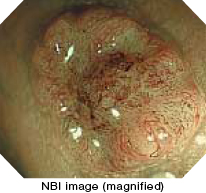
Esophagus
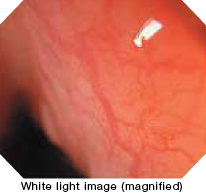

Esophagus


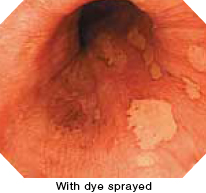
A dedicated built-in optical filter incorporated in the light source is used to generate narrow-band light. This narrow-band illumination is composed of 415 nm light and 540 nm light. Because these wavelengths are strongly absorbed by hemoglobin, they are ideal for depiction of vascular images.
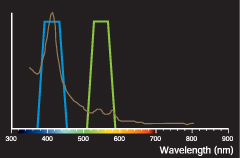
By optimizing the light wavelengths at 415 nm and 540 nm and by keeping their spectral widths narrow, NBI (Narrow Band Imaging) enhances contrast to ensure that blood vessels in the mucosa stand out clearly.
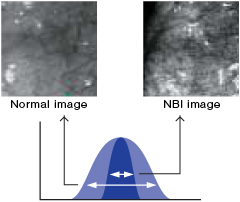
Because the 415 nm and 540 nm wavelengths transmit to different depths in the mucosal tissue, visualization of blood vessel distribution in the mucosa is improved. Capillaries in the superficial layer are emphasized by the 415 nm light and displayed in brown, while veins in the submucosa are made visible by the 540 nm light and displayed in cyan.

Thanks to a large amount of clinical evidence, NBI really opens up many possibilities for diagnosis throughout a hospital*. The high contrast between vessels and the surrounding mucosa means NBI facilitates the detection and characterization of tumors and even displays highly vascularized suspect lesions in deeper tissue layers. Compared with white light endoscopy, the images of capillaries are less blurred and the probability of missing a lesion is reduced. As such, NBI improves specialists' ability to reach an early and precise optical diagnosis.
To date, clinical application and efficacy in different specialties have been studied.
NBI has clinical applications throught the anatomy including gastroenterology,pulmonary, urology and rhinolaryngology (ENT).
Reproduction of lifelike images that depict the subtlest nuances
The accuracy of the results obtained with NBI and AFI depends on the quality of the original images captured by the scope. To ensure the highest possible quality, we naturally incorporated today's most advanced video technology in new generation video system — HDTV or high-definition television.* Composed of more than double the number of scanning lines and horizontal pixels used in conventional video systems, HDTV images offer a 100 percent increase in image information that produces a sharp, detailed picture with virtually no detectable pixelation or artifacts. HDTV's true-to-life imaging power enables even minute capillaries and subtle mucosal structures to be rendered accurately throughout the screen area. This enhanced image quality may improve diagnostic capability and procedural efficiency, while possibly reducing the miss ratio.
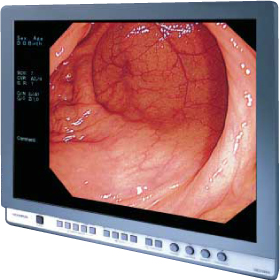
When capturing a still image, this function automatically selects the sharpest image of the desired view.
A new pre-freeze function saves time and helps eliminate the physician's frustration when capturing still images. The new generation video processor automatically buffers a continuous, rapid series of procedural images. When capturing a still image, the pre-freeze function analyzes the previous images and displays and saves the sharpest image of the desired view. This function helps physicians obtain a clear visual record of the procedure in the shortest possible time.

New two-stage optical lens technology allows physicians to switch from normal focus mode to near focus mode with a single button.
Dual focus two-stage optical lens technology from Olympus allows physicians to switch from normal focus mode to near focus mode with a single button, so they can conduct close examination of mucosal tissue and capillary networks. The new technology lets physicians select the desired depth of field and obtain high-quality images at the same time, bringing a new level of visualization to routine examinations.


NBI is the world's only patented endoscopic light technology that enables effective targeting of biopsies not seen under white light without the need for dyes or drugs.
* NBI is not intended to to replace histopathological sampling as a means of diagnosis.
Olympus developed narrow band imaging technology to enhance the examination and characterization of healthy and abnormal mucosal tissue. NBI has set a new standard in endoscopy.
Now with the cutting-edge EVIS EXERA III system, the improved NBI takes HDTV imaging to a completely new level. Each component has been enhanced to achieve the best possible images. Combining a brighter light source, a more sensitive CCD, and 3D noise reduction, the whole system provides up to twice the viewable distance as compared to EVIS EXERA II, which opens up new clinical applications and reinforces NBI's acceptance as a standard of care.
Developed to enhance vascular and surface patterns, NBI now features twice the viewable distance, improved noise reduction that works more efficiently, and image response speed from dark to bright is much faster. These advances help physicians to detect and characterize lesions even more effectively. Many experts agree that NBI can contribute to real-time diagnosis of adenoma and hyperplasia, potentially reducing the frequency of unnecessary biopsies and the costs associated with histopathological examinations. Potential benefits like these, together with NBI's proven practical advantages, are laying the foundations for a new paradigm in endoscopy.
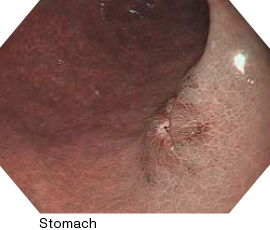


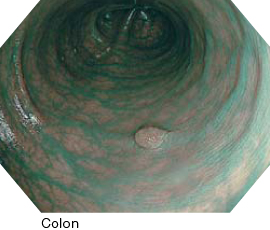
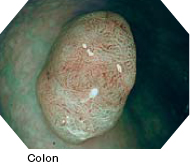
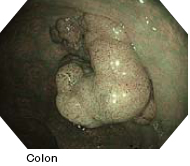
Narrow Band Imaging (NBI) is the world's only patented endoscopic light technology that enables effective targeting of biopsies not seen under white light without the need for dyes or drugs. Narrow Band Imaging (NBI) is a powerful optical image enhancement technology that improves the visibility of blood vessels and other structures on the bladder mucosa.
Reviewing the literature, 50-70% of NMIBC patients suffer from recurrences after the initial treatment in form of superficial tumours*1. Missing small papillary tumours or CIS is an acknowledged risk, at an estimated rate of 10-20%*2. Superficial tumours of the mucosa are typically indicated by specific capillary and vessel structures.

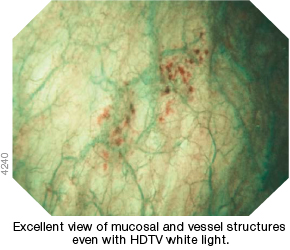
Identifying these structures - especially small tumours under white light conditions - is possible, but could be improved. This is where the HD-NBI technology helps by enhancing the contract of vessels.
NBI technology has potenital to improve visualization of lesion boundaries in Non-Muscle-Invasive Bladder Cancer (NMIBC)

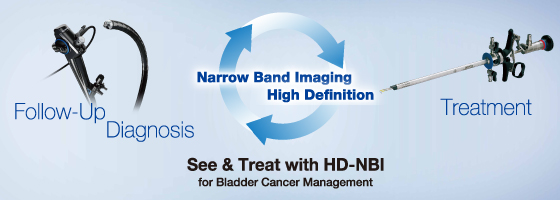
HD-NBI is an extremely valuable help during your follow-up cystoscopies. Being able to switch on NBI by a push of a button during the ambulatory flexible cystoscopy can add great benefits to your diagnosis preciseness.
The combination of HD and Brighter NBI opens a new chapter in advanced bladder cancer follow up diganosis using flexible cystoscopy.
Using the latest generation of HD-NBI camera heads in combination with rigid cystoscopes and resectoscopes enables you to make use of the NBI-related detection benefits during your TUR-BT surgery.
When being confronted with upper tract tumours, using videoscope technology is already a significant step forward.
NBI - available for all endo-urological procedure
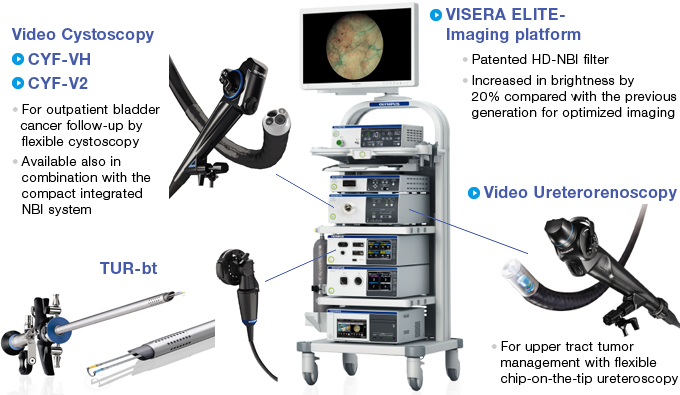
NBI Is an optical imaging technology that enhances the visibility of vessels and other structures on or near the mucosal surface. The gastrointestinal tract is mainly composed of blood vessels and mucosa; narrow band imaging, which is strongly absorbed by hemoglobin and penetrates only the surface of tissues, is ideal for enhancing the contrast between the two. As a result, under narrow band imaging, capillaries on the mucosal surface are displayed in brown and veins in the submucosa are displayed in cyan on the monitor.
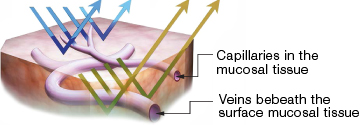

NBI is a potentially useful technique for diagnosis, treatment and follow-up of laryngeal and hypopharyngeal disease. The Narrow Band Imaging (NBI) technology allows for the enhanced visibility of vessel structures leading to support the improved detection of carcinoma in situ in the larynx* as well as saving healthy mucosa due to more precisely defined borders.
High-resolution HDTV image deliver sharp and clear details, boosting observation capabilities when viewing mucosal structures and other vessel patterns. This superior performance will the potential of endoscopy to a new level. This advanced visualization technology potentially reduced unceccesay biopsies and improves examination quality. The combination of HDTV and NBI in ENT are now available to support to optimal diagnsis and treatment. The brilliant HD resolution is the basis for the high accuracy in ENT diagnostic and therapeutic procedures.
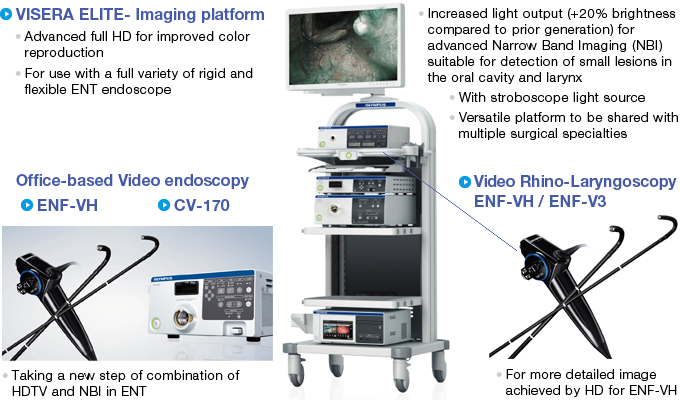
Theory of NBI
EVIS EXERA III GIF-HQ190
Courtesy of Dr. Roy Soetikno, M.D.
EVIS EXERA III CF-HQ190
Courtesy of Dr. Roy Soetikno, M.D.
All with NBI
This website contents and products appearing are applicable for the healthcare professionals in Asia-Pacific area.
Please contact Olympus for further information.
Contents end